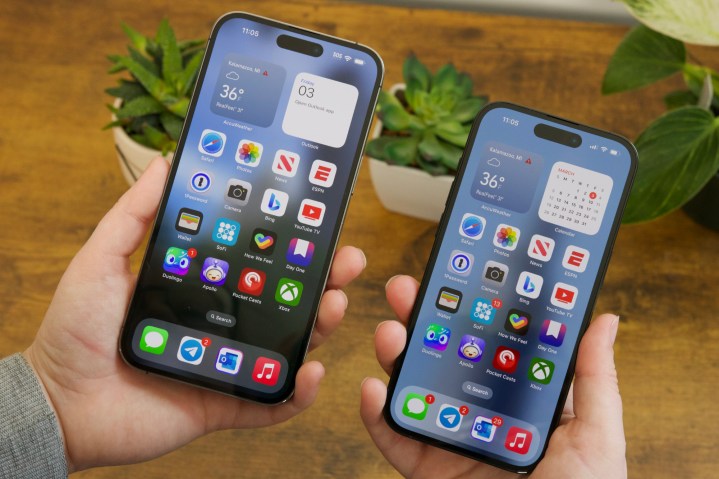
Since its landmark introduction in 2007, Apple has released 42 iPhone models, and with at least four new ones introduced every fall, the company is showing no signs of slowing down.
In all that time, Apple has made relatively few significant design changes. The company tends to stick with established designs for three or four years before changing things up, which can sometimes make it difficult to tell which iPhone model you have — especially if you’re getting a secondhand iPhone (with no box to offer a hint) rather than a new one.
For instance, while an iPhone 15 Pro Max is a very obviously different beast from an iPhone 8, you’d have a harder time differentiating it from an iPhone 14 Pro Max or even an iPhone 13 Pro Max without a trained eye. Likewise, Apple deliberately chose to use the iPhone 8 design for its 2020 and 2022 iPhone SE models, making it nearly impossible to tell those three apart.
In some cases, a unique color might provide a clue, and there are other cues that those familiar with Apple’s iPhones could know to look for. Of course, most folks don’t have the time for that kind of minutiae of Apple product design, so you’ll be happy to know there’s a much easier way to find out what model of iPhone you’re holding in your hand.
How to find out which iPhone you have

Presuming the iPhone is in working condition and you can unlock it, the easiest way to identify it is to open the Settings app and then select General > About.
This page provides helpful information about your iPhone, including its model number and the model name if you’re running iOS 12.2 or later. You can also see what version of iOS is installed, the serial number, and information on AppleCare coverage, storage capacity, and technical information on its Wi-Fi, Bluetooth, and cellular hardware.
If you’re dealing with an older iPhone that hasn’t been updated to at least iOS 12.2, you’ll only see the model number, so you’ll need to do a bit more digging to find out what specific model name it corresponds to.
There are actually two model numbers involved here. The one shown by default is your iPhone’s “part number” — a specific code corresponding to your iPhone’s storage capacity, color, and region. It usually begins with an “M,” although it could be an “N” or an “F” if you’re dealing with a replacement or refurbished iPhone.
However, the number you want to see — the actual model number — is hidden behind the part number. Tap the number beside Model Number, which will change to a shorter five-character code starting with the letter “A.” This model number is common to all colors and storage capacities.

For example, while MQ9E3VC/A is specifically for a Deep Purple, 256GB iPhone 14 Pro Max sold in Canada, the same A2893 model number is used for all variants of the
Note that Apple typically sells unique base models of each iPhone in various areas worldwide to handle different 5G or LTE frequencies. For instance, the iPhone 14 Pro sold in the U.S. that offers mmWave capabilities has a model number of A2650, while the A2889 version sold in Canada supports only sub-6GHz 5G. Apple provides a list of which
What to do if you can’t turn on or unlock your iPhone

While looking in the Settings app is the easiest way by far to find out what model of iPhone you’re using, that won’t be an option if you can’t get to that screen. For example, you may want to know the model of an iPhone that’s been damaged or won’t turn on so you can decide whether it’s worth repairing.
If you’re dealing with an

Fortunately, the model number is still engraved on the iPhone — it’s just in a far less obvious place. Instead, Apple has etched it in really fine print into the SIM tray slot. You’ll need really good eyes or a magnifying glass to see it, but if you pop out your SIM tray and squint at the inside edge of where it slides in, you can find the A-series model number hidden on the display side.
If you’re using an iPhone 15 without a physical SIM card slot, you’ll find the model number inside the Lightning connector instead.
A complete list of all 42 iPhone models

Once you’ve found the model number for your iPhone, you can check the following list to match it up. This is a list of every iPhone model Apple has ever launched, from most recent to oldest, including all the model numbers for each region.
- 2023
- iPhone 15 Pro Max: A2849, A3105, A3106, A3108
- iPhone 15 Pro: A2848, A3101, A3102, A3104
- iPhone 15 Plus: A2846, A3090, A3091, A3093
- iPhone 15: A2846, A3090, A3091, A3093
- 2022
- iPhone 14 Pro Max: A2651, A2893, A2896, A2895, A2894
- iPhone 14 Pro: A2650, A2889, A2892, A2891, A2890
- iPhone 14 Plus: A2632, A2885, A2888, A2887, A2886
- iPhone 14: A2649, A2881, A2884, A2883, A2882
- iPhone SE (2022): A2595, A2782, A2784, A2783
- 2021
- iPhone 13 Pro Max: A2484, A2641, A2644, A2645, A2643
- iPhone 13 Pro: A2483, A2636, A2639, A2640, A2638
- iPhone 13: A2482, A2631, A2634, A2635, A2633
- iPhone 13 Mini: A2481, A2626, A2629, A2630, A2628
- 2020
- iPhone 12 Pro Max: A2342, A2410, A2412, A2411
- iPhone 12 Pro: A2341, A2406, A2408, A2407
- iPhone 12 Mini: A2176, A2398, A2400, A2399
- iPhone 12: A2172, A2402, A2404, A2403
- iPhone SE (2020): A2275, A2296, A2298
- 2019
- iPhone 11 Pro: A2160, A2217, A2215
- iPhone 11 Pro Max: A2161, A2220, A2218
- iPhone 11: A2111, A2223, A2221
- 2018
- iPhone XS: A1920, A2097, A2098, A2099, A2100
- iPhone XS Max: A1921, A2101, A2102, A2103, A2104
- iPhone XR: A1984, A2105, A2106, A2107, A2108
- 2017
- iPhone X: A1865, A1901, A1902
- iPhone 8: A1863, A1905, A1906
- iPhone 8 Plus: A1864, A1897, A1898
- 2016
- iPhone 7: A1660, A1778, A1779
- iPhone 7 Plus: A1661, A1784, A1785
- iPhone SE: A1723, A1662, A1724
- 2015
- iPhone 6S: A1633, A1688, A1700
- iPhone 6S Plus: A1634, A1687, A1699
- 2014
- iPhone 6: A1549, A1586, A1589
- iPhone 6 Plus: A1522, A1524, A1593
- 2013
- iPhone 5S: A1453, A1457, A1518, A1528, A1530, A1533
- iPhone 5C: A1456, A1507, A1516, A1529, A1532
- 2012
- iPhone 5: A1428, A1429, A1442
- 2011
- iPhone 4S: A1431, A1387
- 2010
- iPhone 4: A1349, A1332
- 2009
- iPhone 3GS: A1325, A1303
- 2008
- iPhone 3G: A1324, A1241
- 2007
- iPhone: A1203
Editors' Recommendations
- Best refurbished iPhone deals: Get an iPhone 14 for $513
- Best iPhone deals: Save on iPhone 15, iPhone 15 Pro Max and more
- iPhone SE 4: news, rumored price, release date, and more
- Best iPhone 15 deals: How to get Apple’s latest iPhone for free
- The 10 best photo editing apps for Android and iOS in 2024





